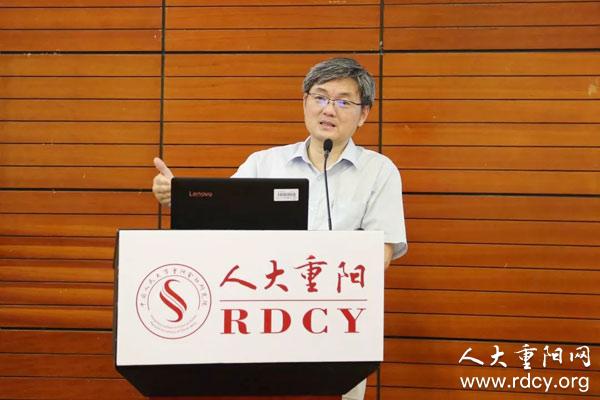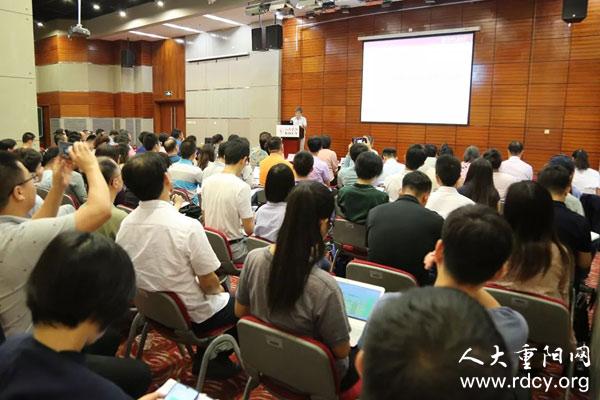Picture
Your Present Location: HOME> PictureYang Ruilong: logic, dilemma and future directions of China’s SOEs reform
On July 3, 2019, Yang Ruilong, a professor at Renmin University of China, was invited to deliver a lecture sharing " Evolution and reflection of the Logic of China's State-owned Enterprise Reform (SOEs)".
Professor Yang Ruilong said that the reform of SOEs has two difficulties. The first is the separation of government functions from enterprise management. The reform target is to realize full fledged and self-financing enterprise, and to enable enterprises to pursue profit maximization.
However, the ownership of state-owned enterprises belongs to the state. This has encountered a great contradiction. The goal of the reform is to let enterprises pursue profit maximization, but the owner’s goal is not to pursue profit maximization, this is a dilemma.

In order to solve this contradiction in practice, we should separate the government functions from enterprise management. The separation has become a very important reform goal for us and has been explored for 30 years. But during the reform, we found it is very hard. Because the separation of the government function from enterprises management means that the government really does not have any influence in the enterprise, and the enterprise must not be state-owned.
The second problem is that ownership is non-transferable. As a main body of the market, the assets of this enterprise must be constantly replaced. For private enterprises, the change of assets has no loss, as long as the rate of return on profits is higher than the past. However, state-owned enterprises have a departmental ownership system, and each enterprise has its own government department in charge. Once the assets are replaced and the ownership is changed, the subject will change.
how to solve these two problems? We have an unprecedented lack in theory, if we use the mainstream western economic theory to dominate the reform of state-owned enterprises, the only way is privatization. This logic will not work in China, because China is not a western-style market economy.
Another theory is political economy to discuss SOEs reform, which is also very difficult. Because this logic is difficult to explain that under socialist conditions, the market mechanism should play a decisive role.

Professor Yang Ruilong pointed out that the reform direction of SOEs is classified reform. In the process of marketization, not all state-owned enterprises should be market-oriented, and different types of state-owned enterprises should choose different reform ideas and paths. Some public welfare state-owned enterprises do not need to become the main body of the market.
We can classified the state-owned enterprises by two criteria: one is divided into competitive and non-competitive industries according to the nature of the industry in which state-owned enterprises are located, and the other is divided into public products and private products according to the nature of products provided by state-owned enterprises. The state-owned enterprises in different industries and different product should choose different reform paths.
If the industry nature of the enterprise is monopolistic, then it is owned and operated by the state; if its product nature is private and the nature of the industry is monopolistic, it also should be controlled by the state. If the nature of the product is private and the nature of the industry is competitive, then diversification or denationalization of property rights will be implemented in the enterprise.
Professor Yang added that mixed ownership reform should be promoted in the classified reform. There are many forms of mixed ownership, specifically, state-owned enterprises can take shares in private enterprises, private enterprises can take shares in state-owned enterprises, and encourage the shareholding of employees in the state-owned enterprises. State-owned enterprises in monopoly industries have market dominance and financing advantages, which is the weakness of the private enterprises; the advantage of private enterprises is flexible management mechanism, which is the short board of state-owned enterprises. If the two kinds of enterprise mixed, they are all going to get what they need.
Whether the market economy can take another step forward depends on the reform of state-owned enterprises. The core of market reform is property right reform. How to push the state-owned enterprises to the market through the mixed ownership reform, a reform dynamic mechanism needed to be introduced. Reshaping the reform dynamic mechanism is the key to promote the mixed ownership reform.























































































 京公网安备 11010802037854号
京公网安备 11010802037854号





